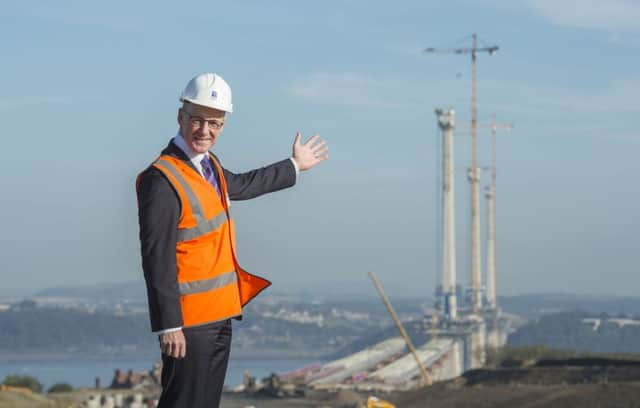Leaders: Swinney to feel transport budget pressure


It is an all-too familiar feature of modern Scottish budgets: the Finance Secretary puts on his grimmest expression and warns us all of “challenges ahead”.
This year the expression is all the more grim and the rhetoric more chilling, with a pre-budget warning of “tough choices”.
Advertisement
Hide AdAdvertisement
Hide AdAhead of the fiscal statement on Wednesday comes an advance warning of the cuts to the Scottish Government’s budget.
While this is expected to grow in real terms next year (2016-17) it will fall in real terms in each of the subsequent years to 2019-20.
Indeed, Mr Swinney makes the most of the misery: the combination of cuts imposed since 2010 and last month’s spending review means that by 2019-20 his discretionary budget will be 12.5 per cent lower in real terms than it was in 2010-11, with some 4.2 per cent of this reduction coming between now and 2019-20.
Put like this, it is not hard to despair of Scotland’s fiscal fortunes. But when expressed as annual changes over the next four years, the picture looks decidedly less grim.
The “Departmental Expenditure Limit” rises each year between 2016-17 and 2019-20. In real terms, the reduction is 1.2 per cent in 2017-18, 1.6 per cent in 2018-19 and 1.4 per cent in 2019-20. Irksome though these may be, there is barely a commercial enterprise that has not had to improve efficiencies and trim its budget by much greater amounts.
At the same time, as Mr Swinney will lose no opportunity to remind us, the budgets of schools, hospitals and the police service in Scotland have been protected, with the Scottish Government claiming more police officers, lower crime, better schools, tuition-free university education and a record health budget.
The economy has continued to enjoy growth, while latest figures show a new record output from the Scottish construction industry over the year to September rising to more than £14 billion – all this defying predictions that public spending constraint would dash recovery.
Tough choices there have certainly been, and more are on the way. But it hardly merits the description of “austerity”.
Advertisement
Hide AdAdvertisement
Hide AdThat said, Mr Swinney is under particular pressure this week to maintain public expenditure on our transport infrastructure. The closure of the Forth Road Bridge for vital repairs and the severe disruption this has brought for commuters and businesses dependent on this critical artery vividly demonstrates the need for such spending not only to be maintained but also increased to avoid future problems. Pruning back on regular maintenance is far from a saving but a course that can have highly disruptive and costly consequences.
In addition to the extra maintenance work now involved, the Holyrood administration is now under pressure to ensure more investment in public transport in the wake of the bridge closure.
While prompt action has been taken to reduce the disruption to travellers, the Scottish Association for Public Transport and transport alliance Transform Scotland have appealed to Mr Swinney to prioritise public transport over road building. It is a call that will meet with wide public support.
Innovation will improve our world
After many long days and nights in Paris, a final agreement to tackle climate change was finally reached across 195 nations. US president Barack Obama has hailed it as “a turning point for the world”. China, the world’s biggest polluter, and India, whose economy is also vitally dependent on coal consumption, have also hailed the deal, with its agreement to cut emissions and reduce the rise in global temperatures to “well below” 2C.
In all of this, Scotland has sought to set an example through ambitious climate change legislation. And as First Minister Nicola Sturgeon said yesterday, what matters now is that the rhetoric is backed up by meaningful action, particularly in the drive to develop renewables and carbon capture and storage.
As the administration has found, this has proved easier to proclaim than to achieve. UK wind farm subsidies have been cut. There has been growing questioning of the impact of the cost of climate change legislation on fuel consumers, particularly those in fuel poverty. And ambitious projects to capture wave power offshore Scotland have not been successful.
Policy has to strike a balance between the ambitions to reduce reliance on fossil fuel and minimise the cost to households and businesses of a fundamental transition of our economy towards renewable energy.
Many feel the Paris agreement is not ambitious enough and that sanctions will be required to curb big polluters. But securing agreement even on this limited set of goals has been arduous.
Advertisement
Hide AdAdvertisement
Hide AdIt is easy to despair. But our best hope lies in continuing improvements in technology to drive down the costs of renewables and improve energy efficiency. The constant drive to innovation and improvement should help propel us to a cleaner, healthier and safer world.